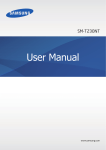Download Samsung Galaxy Tab 3 SM-T310 16GB White
Transcript
SM-T310 User Manual www.samsung.com About this manual This device provides high quality mobile communication and entertainment using Samsung’s high standards and technological expertise. This user manual is specially designed to detail the device’s functions and features. • Please read this manual before using the device to ensure safe and proper use. • Descriptions are based on the device’s default settings. • Images and screenshots may differ in appearance from the actual product. • Content may differ from the final product, or from software provided by service providers or carriers, and is subject to change without prior notice. For the latest version of the manual, refer to the Samsung website, www.samsung.com. • Content (high quality content) that requires high CPU and RAM usage will affect the overall performance of the device. Applications related to the content may not work properly depending on the device’s specifications and the environment that it is used in. • Available features and additional services may vary by device, software, or service provider. • Applications and their functions may vary by country, region, or hardware specifications. Samsung is not liable for performance issues caused by applications from any provider other than Samsung. • Samsung is not liable for performance issues or incompatibilities caused by edited registry settings or modified operating system software. Attempting to customise the operating system may cause the device or applications to work improperly. • Software, sound sources, wallpapers, images, and other media provided with this device are licensed for limited use. Extracting and using these materials for commercial or other purposes is an infringement of copyright laws. Users are entirely responsible for illegal use of media. 2 About this manual • Default applications that come with the device are subject to updates and may no longer be supported without prior notice. If you have questions about an application provided with the device, contact a Samsung Service Centre. For user-installed applications, contact service providers. • Modifying the device’s operating system or installing softwares from unofficial sources may result in device malfunctions and data corruption or loss. These actions are violations of your Samsung licence agreement and will void your warranty. Instructional icons Warning: situations that could cause injury to yourself or others Caution: situations that could cause damage to your device or other equipment Note: notes, usage tips, or additional information Copyright Copyright © 2014 Samsung Electronics This guide is protected under international copyright laws. No part of this guide may be reproduced, distributed, translated, or transmitted in any form or by any means, electronic or mechanical, including photocopying, recording, or storing in any information storage and retrieval system, without the prior written permission of Samsung Electronics. 3 About this manual Trademarks • SAMSUNG and the SAMSUNG logo are registered trademarks of Samsung Electronics. • Bluetooth® is a registered trademark of Bluetooth SIG, Inc. worldwide. • Wi-Fi®, Wi-Fi Protected Setup™, Wi-Fi Direct™, Wi-Fi CERTIFIED™, and the Wi-Fi logo are registered trademarks of the Wi-Fi Alliance. • All other trademarks and copyrights are the property of their respective owners. DivX®, DivX Certified® and associated logos are trademarks of Rovi Corporation or its subsidiaries and are used under licence. ABOUT DIVX VIDEO DivX® is a digital video format created by DivX, LLC, a subsidiary of Rovi Corporation. This is an official DivX Certified® device that has passed rigorous testing to verify that it plays DivX video. Visit www.divx.com for more information and software tools to convert your files into DivX videos. ABOUT DIVX VIDEO-ON-DEMAND This DivX Certified® device must be registered in order to play purchased DivX Video-onDemand (VOD) movies. To obtain your registration code, locate the DivX VOD section in your device setup menu. Go to vod.divx.com for more information on how to complete your registration. DivX Certified® to play DivX® video up to HD 720p, including premium content. Manufactured under licence from Dolby Laboratories. Dolby, Dolby Digital Plus, and the double-D symbol are trademarks of Dolby Laboratories. 4 Table of Contents Getting started 37 38 39 41 8 Device layout 9Buttons 10 Package contents 10 Charging the battery 13 Inserting a memory card 15 Turning the device on and off 15 Holding the device 16 Locking and unlocking the device 16 Adjusting the volume 16 Switching to silent mode Setting up accounts Transferring files Securing the device Upgrading the device Communication 42Contacts 46Email 47 Google Mail 49Hangouts 49Google+ 50Photos 50Twitter Basics 17 Indicator icons 18 Using the touch screen 21 Control motions 23 Using Multi Window 27Notifications 28 Home screen 30 Locked screen 31 Applications screen 33 Using applications 33Help 34 Entering text 36 Connecting to a Wi-Fi network Web & network 51Internet 52Chrome 53Bluetooth 54 Screen Mirroring 55 Samsung Link 56 Group Play 58WatchON 5 Table of Contents Media 93Calculator 93 S Translator 94 S Voice 95Google 96 Voice Search 96 My Files 97Downloads 97TripAdvisor 59Music 61Camera 66Gallery 70 Story Album 74 Paper Artist 75Video 76YouTube 77Flipboard Travel & local Application & media stores 78 79 79 80 81 81 81 81 82 82 82 98Maps Play Store Samsung Apps Game Hub Music Hub Play Books Play Movies Play Music Play Games Play Newsstand Readers Hub Video Hub Settings 99 About Settings 99Wi-Fi 100Bluetooth 100 Data usage 101 More settings 102 Blocking mode 102 Hands-free mode 102Sound 103Display 104Storage 104 Power saving mode 105Battery 105 Application manager 105 Default applications 105Location 106 Lock screen 107Security 108 Language and input 111Cloud Utilities 83Memo 84 S Planner 87Dropbox 88Cloud 88Drive 89 POLARIS Office 5 91Alarm 92 World Clock 6 Table of Contents 111 Backup and reset 112 Add account 112Motion 112 Voice control 112Accessories 113 Date and time 113Accessibility 114 About device 114 Google Settings Troubleshooting 7 Getting started Device layout Front camera Light sensor Microphone Power button Volume button Touch screen IrLED Home button Back button Menu button Multipurpose jack Headset jack Rear camera GPS antenna Memory card slot Speaker Speaker 8 Getting started • Do not cover the antenna area with your hands or other objects. This may cause connectivity problems or drain the battery. • Do not use a screen protector. This causes sensor malfunctions. • Do not allow water to contact the touch screen. The touch screen may malfunction in humid conditions or when exposed to water. Buttons Button Function • Press and hold to turn the device on or off. Power Menu Home • Press and hold for 8-10 seconds to reset the device if it has fatal errors or hang-ups, or freezes. • Press to lock or unlock the device. The device goes into lock mode when the touch screen turns off. • Tap to open a list of options available for the current screen. • Tap and hold to launch Google search. • Press to return to the Home screen. • Press and hold to open the list of recent applications. Back • Tap to return to the previous screen. Volume • Press to adjust the device volume. 9 Getting started Package contents Check the product box for the following items: • Device • Quick start guide • The items supplied with the device and any available accessories may vary depending on the region or service provider. • The supplied items are designed only for this device and may not be compatible with other devices. • Appearances and specifications are subject to change without prior notice. • You can purchase additional accessories from your local Samsung retailer. Make sure they are compatible with the device before purchase. • Other accessories may not be compatible with your device. • Use only Samsung-approved accessories. Malfunctions caused by using unapproved accessories are not covered by the warranty service. • Availability of all accessories is subject to change depending entirely on manufacturing companies. For more information about available accessories, refer to the Samsung website. Charging the battery Use the charger to charge the battery before using it for the first time. Use only Samsung-approved chargers, batteries, and cables. Unapproved chargers or cables can cause the battery to explode or damage the device. • When the battery power is low, the battery icon appears empty. • If the battery is completely discharged, the device cannot be turned on immediately when the charger is connected. Allow a depleted battery to charge for a few minutes before turning on the device. 10 Getting started Charging with the charger Connect the USB cable to the USB power adaptor and then plug the end of the USB cable into the multipurpose jack. Connecting the charger improperly may cause serious damage to the device. Any damage caused by misuse is not covered by the warranty. • The device can be used while it is charging, but it may take longer to fully charge the battery. • If the device receives an unstable power supply while charging, the touch screen may not function. If this happens, unplug the charger from the device. • While charging, the device may heat up. This is normal and should not affect the device’s lifespan or performance. If the battery gets hotter than usual, the charger may stop charging. • If the device is not charging properly, take the device and the charger to a Samsung Service Centre. 11 Getting started After fully charging, disconnect the device from the charger. First unplug the charger from the device, and then unplug it from the electric socket. To save energy, unplug the charger when not in use. The charger does not have a power switch, so you must unplug the charger from the electric socket when not in use to avoid wasting power. The charger should remain close to the electric socket and easily accessible while charging. Checking the battery charge status When you charge the battery while the device is off, the following icons will show the current battery charge status: Charging Fully charged Reducing the battery consumption Your device provides options that help you save battery power. By customising these options and deactivating features in the background, you can use the device longer between charges: • When you are not using the device, switch to sleep mode by pressing the Power button. • Close unnecessary applications with the task manager. • Deactivate the Bluetooth feature. • Deactivate the Wi-Fi feature. • Deactivate auto-syncing of applications. • Decrease the backlight time. • Decrease the brightness of the display. 12 Getting started Inserting a memory card Your device accepts memory cards with maximum capacities of 64 GB. Depending on the memory card manufacturer and type, some memory cards may not be compatible with your device. • Some memory cards may not be fully compatible with the device. Using an incompatible card may damage the device or the memory card, or corrupt the data stored in it. • Use caution to insert the memory card right-side up. • The device supports only the FAT file system for memory cards. When inserting a card formatted in a different file system, the device asks to reformat the memory card. • Frequent writing and erasing of data shortens the lifespan of memory cards. • When inserting a memory card into the device, the memory card’s file directory appears in the SD memory card folder. 1 Insert a memory card with the gold-coloured contacts facing downwards. 2 Push the memory card into the slot until it locks in place. 13 Getting started Removing the memory card Before removing the memory card, first unmount it for safe removal. On the Home screen, tap Apps → Settings → Storage → Unmount SD card. Push the memory card until it disengages from the device, and then pull it out. Do not remove the memory card while the device is transferring or accessing information. Doing so can cause data to be lost or corrupted or damage to the memory card or device. Samsung is not responsible for losses that result from the misuse of damaged memory cards, including the loss of data. Formatting the memory card A memory card formatted on a computer may not be compatible with the device. Format the memory card on the device. On the Home screen, tap Apps → Settings → Storage → Format SD card → Format SD card → Erase everything. Before formatting the memory card, remember to make backup copies of all important data stored on the device. The manufacturer’s warranty does not cover loss of data resulting from user actions. 14 Getting started Turning the device on and off When turning on the device for the first time, follow the on-screen instructions to set up your device. Press and hold the Power button for a few seconds to turn on the device. • Follow all posted warnings and directions from authorised personnel in areas where the use of wireless devices is restricted, such as aeroplanes and hospitals. • Press and hold the Power button and tap Flight mode to disable the wireless features. To turn off the device, press and hold the Power button, and then tap Power off. Holding the device Do not cover the antenna area with your hands or other objects. This may cause connectivity problems or drain the battery. 15 Getting started Locking and unlocking the device When not in use, lock the device to prevent unwanted operation. Pressing the Power button turns off the screen and puts the device into lock mode. The device automatically gets locked if it is not used for a specified period. To unlock the device, press the Power button or the Home button and flick your finger in any direction within the unlock screen area at the lower part of the screen. Adjusting the volume Press the Volume button up or down to adjust the ringtone volume, or to adjust the sound volume when playing music or video. Switching to silent mode Use one of the following methods: • Press and hold the Volume button down until it switches to silent mode. • Press and hold the Power button, and then tap Mute. • Open the notifications panel at the top of the screen, and then tap Sound. 16 Basics Indicator icons The icons displayed at the top of the screen provide information about the status of the device. The icons listed in the table below are most common. Icon Meaning Wi-Fi connected Bluetooth feature activated GPS activated Synced with the web Connected to computer Alarm activated Mute mode activated Flight mode activated Error occurred or caution required Battery power level 17 Basics Using the touch screen Use only fingers to use the touch screen. • Do not allow the touch screen to come into contact with other electrical devices. Electrostatic discharges can cause the touch screen to malfunction. • To avoid damaging the touch screen, do not tap it with anything sharp or apply excessive pressure to it with your fingertips. • The device may not recognise touch inputs close to the edges of the screen, which are outside of the touch input area. • Leaving the touch screen idle for extended periods may result in afterimages (screen burn-in) or ghosting. Turn off the touch screen when you do not use the device. Finger gestures Tapping To open an application, to select a menu item, to press an on-screen button, or to enter a character using the on-screen keyboard, tap it with a finger. 18 Basics Dragging To move an icon, thumbnail, or preview to a new location, tap and hold it and drag it to the target position. Double-tapping Double-tap on a webpage or image to zoom in a part. Double-tap again to return. 19 Basics Flicking Flick left or right on the Home screen or the Applications screen to see another panel. Flick up or down to scroll through a webpage or a list, such as contacts. Pinching Spread two fingers apart on a webpage, map, or image to zoom in a part. Pinch to zoom out. 20 Basics Control motions Simple motions allow easy control of the device. Before using motions, make sure the motion feature is activated. On the Home screen, tap Apps → Settings → Motion, and then drag the switch at the top right of the screen to the right. Rotating the screen Many applications allow display in either portrait or landscape orientation. Rotating the device causes the display to automatically adjust to fit the new screen orientation. To prevent the display from rotating automatically, open the notifications panel and deselect Screen rotation. • Some applications do not allow screen rotation. • Some applications display a different screen depending on the orientation. The calculator turns into a scientific calculator when rotated to landscape. 21 Basics Sweeping Sweep your hand across the screen to capture a screenshot. The image is saved in Gallery → Screenshots. It is not possible to capture a screenshot while using some applications. Covering Cover the screen with a palm to pause media playback. 22 Basics Using Multi Window Use this feature to run multiple applications on the screen at the same time. • Only applications on the Multi Window tray can run. • This feature may not be available depending on the region or service provider. To use Multi Window, on the Home screen, tap Apps → Settings → Display, and then tick Multi window. Using a split screen Multi Window Use this feature to run applications in a split screen. Launching applications in a split screen Multi Window 1 Drag your finger from the right edge of the screen towards the middle of the screen. Alternatively, tap and hold . The Multi Window tray appears at the right side of the screen. Multi Window tray 23 Basics 2 Tap and hold an application icon on the Multi Window tray, and then drag it to the screen. Release the application icon when the screen turns blue. 3 Tap and hold another application icon on the Multi Window tray, and then drag it to a new location. 24 Basics Sharing content between applications You can easily share content between applications, such as Email and Internet, by dragging and dropping them. Some applications may not support this feature. 1 Launch Email and Internet in a split screen Multi Window. Access the Multi Window options 2 Tap the circle between the application windows, and then tap . Tap the circle between application windows to access the following options: • : Switch locations between Multi Window applications. • : Share items, such as images, text, or links, between application windows by dragging and dropping them. • : Maximise the window. • : Close the application. 25 Basics 3 Tap and hold an item in the Internet window and drag it to a location in the Email window. Creating a Multi Window combination Use this feature to save currently-running Multi Window applications as a combination. 1 Launch multiple applications in a split screen Multi Window. 2 Open the Multi Window tray and tap → Create. 3 Enter a title and tap OK. The currently-running Multi Window combination is added to the Multi Window tray. To launch applications using a saved combination, select the combination from the Multi Window tray. 26 Basics Notifications Notification icons appear on the status bar at the top of the screen to report new messages, calendar events, device status, and more. Drag down from the status bar to open the notifications panel. Scroll the list to see additional alerts. To close the notifications panel, drag up the bar that is at the bottom of the screen. From the notifications panel, you can view your device’s current settings. Drag down from the status bar, and then tap to use the following options: • Wi-Fi: Activate or deactivate the Wi-Fi feature. • Location: Activate or deactivate the GPS feature. • Sound: Activate or deactivate silent mode. • Screen rotation: Allow or prevent the interface from rotating when you rotate the device. • Bluetooth: Activate or deactivate the Bluetooth feature. • Reading mode: Activate or deactivate reading mode. In reading mode, the device helps protect your eyes when reading at night. To select which applications will be used for, tap Settings → Display → Reading mode. • Multi window: Set to use Multi Window. • Screen Mirroring: Activate or deactivate the screen mirroring feature. • Sync: Activate or deactivate auto-syncing of applications. • Smart stay: Activate or deactivate the smart stay feature. • Power saving: Activate or deactivate power-saving mode. • Blocking mode: Activate or deactivate blocking mode. In blocking mode, the device will block notifications. To select which notifications will be blocked, tap Settings → Blocking mode. • Flight mode: Activate or deactivate flight mode. • Hands-free mode: Activate or deactivate hands-free mode. The available options may vary depending on the region or service provider. To rearrange the options on the notifications panel, open the notifications panel, tap tap and hold an item, and then drag the item to another location. 27 → , Basics Home screen The Home screen is the starting point to access all of the device’s features. It displays indicator icons, widgets, shortcuts to applications, and others. The Home screen can have multiple panels. To view other panels, scroll left or right. Rearranging items Adding an application icon On the Home screen, tap Apps, tap and hold an application icon, and then drag it into a panel preview. Adding an item Customise the Home screen by adding widgets, folders, or panels. Tap and hold the empty area on the Home screen, and then select one of the following categories: • Apps and widgets: Add widgets or applications to the Home screen. • Folder: Create a new folder. • Page: Add a new panel to the Home screen. Moving an item Tap and hold an item and drag it to a new location. To move it to another panel, drag it to the side of the screen. Removing an item Tap and hold an item, and drag it to the rubbish bin that appears at the top of the Home screen. When the rubbish bin turns red, release the item. 28 Basics Rearranging panels Adding a new panel Tap → Edit page → . Moving a panel Tap → Edit page, tap and hold a panel preview, and then drag it to a new location. Removing a panel → Edit page, tap and hold a panel preview, and then drag it to the rubbish bin at the Tap top of the screen. Setting wallpaper Set an image or photo stored in the device as wallpaper for the Home screen. On the Home screen, tap following: → Set wallpaper → Home screen, and then select one of the • Gallery: See photos taken by the device’s camera or images downloaded from the Internet. • Live wallpapers: See animated images. • Photos: See images in Photos. • Wallpapers: See wallpaper images. Select an image, resize the frame if necessary, and then set it as wallpaper. 29 Basics Using widgets Widgets are small applications that provide convenient functions and information on your Home screen. To use them, add widgets from the widgets panel to the Home screen. • Some widgets connect to web services. Using a web-based widget may result in additional charges. • The widgets available may vary depending on the region or service provider. On the Home screen, tap Apps → Widgets. Scroll left or right on the widgets panel, and then tap and hold a widget to add it to the Home screen. Put it on a location you want, resize it by dragging the frame if necessary, and then tap anywhere on the screen to save the location of the widget. Locked screen The locked screen prevents the device from unwanted operation when not in use and also allows you to add convenient widgets. Adding widgets To use widgets when the screen is locked, on the Applications screen, tap Settings → Lock screen, and then tick Multiple widgets. You cannot use widgets on the locked screen when the security features are activated. Tap the widgets panel area at the upper part of the screen. Scroll right to the last page, tap and then select a widget to add to the locked screen. 30 , Basics Rearranging panels Moving a panel Scroll left or right on the widgets panel area, tap and hold a panel preview, and then drag it to a new location. Removing a panel Scroll left or right on the widgets panel area, tap and hold a panel preview, and then drag it to the rubbish bin at the top of the screen. Applications screen The Applications screen displays icons for all applications, including any new applications installed. On the Home screen, tap Apps to open the Applications screen. To view other panels, scroll left or right. Rearranging applications This feature is available only in the customisable grid view. → Edit, tap and hold an application, and then drag it to a new location. To move it to Tap another panel, drag it to the side of the screen. Organising with folders Put related applications together in a folder for convenience. → Edit, tap and hold an application, and then drag it to Create folder. Enter a folder Tap name and then tap OK. Put applications into the new folder by dragging, and then tap Save to save the arrangement. 31 Basics Rearranging panels Pinch on the screen, tap and hold a panel preview, and then drag it to a new location. Installing applications Use application stores, such as Samsung Apps, to download and install applications. Uninstalling applications Tap → Uninstall/disable apps, and then select an application to uninstall it. Default applications that come with the device cannot be uninstalled. Disabling applications Tap → Uninstall/disable apps, and then select an application to disable it. To enable the application, on the Applications screen, tap Settings → Application manager, scroll to DISABLED, select the application, and then tap Enable. • Downloaded applications and some default applications that come with the device cannot be disabled. • When you use this feature, disabled applications disappear from the Applications screen but are still stored in the device. 32 Basics Using applications This device can run many different types of applications, ranging from media to Internet applications. Opening an application On the Home screen or the Applications screen, select an application icon to open it. Some applications are grouped into folders. Tap a folder, and then tap an application to open it. Opening from recently-used applications Press and hold the Home button to open the list of recently-used applications. Select an application icon to open. Closing an application Close applications not in use to save battery power and maintain device performance. Press and hold the Home button, tap , and then tap End next to an application to close it. To close all running applications, tap End all. Alternatively, press and hold the Home button, and then tap . Help Access help information to learn how to use the device and applications or configure important settings. Tap Help on the Applications screen. Select a category to view tips. To sort categories by an alphabetical order, tap To search for keywords, tap . 33 . Basics Entering text Use the Samsung keyboard or the voice input feature to enter text. Text entry is not supported in some languages. To enter text, you must change the input language to one of the supported languages. Changing the keyboard type Tap any text field, open the notifications panel, tap Choose input method, and then select the type of keyboard to use. Using the Samsung keyboard Set options for the Samsung keyboard. Delete a preceding character. Break to the next line. Enter uppercase. Enter uppercase. Enter punctuation marks. Add an item from the clipboard. Enter a space. Entering uppercase Tap before entering a character. For all caps, tap it twice. Changing the keyboard type Tap and hold , and then tap to change the keyboard type. On the floating keyboard, tap and hold location. and move the floating keyboard to another Changing language keyboards Add languages on the keyboard, and then slide the space key left or right to change language keyboards. 34 Basics Handwriting Tap and hold → , and then write a word with a finger. Suggested words appear as characters are entered. Select a suggested word. Use handwriting gestures to perform actions, such as editing or deleting characters and inserting spaces. To view the gesture guides, tap and hold , and then tap → Help → Using handwriting gestures. This feature may not be available depending on the region or service provider. Entering text by voice Activate the voice input feature and then speak into the microphone. The device displays what you speak. If the device does not recognise your words correctly, tap the underlined text and select an alternative word or phrase from the dropdown list. To change the language or add languages for the voice recognition, tap the current language. Copying and pasting Tap and hold over text, drag or to select more or less text, and then tap Copy to copy or Cut to cut. The selected text is copied to the clipboard. To paste it into a text entry field, tap and hold at the point where it should be inserted, and then tap Paste. 35 Basics Connecting to a Wi-Fi network Connect the device to a Wi-Fi network to use the Internet or share media files with other devices. (p. 99) Ensure that the Wi-Fi connection is active before using Internet applications. Turning Wi-Fi on and off Open the notifications panel, and then tap Wi-Fi to turn it on or off. • Your device uses a non-harmonised frequency and is intended for use in all European countries. The WLAN can be operated in the EU without restriction indoors, but cannot be operated outdoors. • Turn off Wi-Fi to save the battery when not in use. Joining Wi-Fi networks On the Applications screen, tap Settings → Wi-Fi, and then drag the Wi-Fi switch to the right. Select a network from the list of detected Wi-Fi networks, enter a password if necessary, and then tap Connect. Networks that require a password appear with a lock icon. After the device connects to a Wi-Fi network, the device will automatically connect to it any time it is available. Adding Wi-Fi networks If the desired network does not appear in the networks list, tap Add Wi-Fi network at the bottom of the networks list. Enter the network name in Network SSID, select the security type and enter the password if it is not an open network, and then tap Connect. 36 Basics Forgetting Wi-Fi networks Any network that has ever been used, including the current network, can be forgotten so the device will not automatically connect to it. Select the network in the networks list, and then tap Forget. Setting up accounts Google applications, such as Play Store, require a Google account, and Samsung Apps requires a Samsung account. Create Google and Samsung accounts to have the best experience with the device. Adding accounts Follow the instructions that appear when opening a Google application without signing in to set up a Google account. To sign in with or sign up for a Google account, on the Applications screen, tap Settings → Add account → Google. After that, tap New to sign up, or tap Existing, and then follow onscreen instructions to complete the account setup. More than one Google account can be used on the device. Set up a Samsung account as well. Removing accounts On the Applications screen, tap Settings, select an account name under Accounts, select the account to remove, and then tap Remove account. 37 Basics Transferring files Move audio, video, image, or other types of files from the device to the computer, or vice versa. Connecting with Samsung Kies Samsung Kies is a computer application that manages media contents and personal information with Samsung devices. Download the latest Samsung Kies from the Samsung website. 1 Connect the device to the computer using the USB cable. Samsung Kies launches on the computer automatically. If Samsung Kies does not launch, double-click the Samsung Kies icon on the computer. 2 Transfer files between your device and the computer. Refer to the Samsung Kies help for more information. Connecting with Windows Media Player Ensure that Windows Media Player is installed on the computer. 1 Connect the device to the computer using the USB cable. 2 Open Windows Media Player and sync music files. 38 Basics Connecting as a media device 1 Connect the device to the computer using the USB cable. 2 Open the notifications panel, and then tap Connected as a media device → Media device (MTP). Tap Camera (PTP) if your computer does not support Media Transfer Protocol (MTP) or not have any appropriate driver installed. 3 Transfer files between your device and the computer. Securing the device Prevent others from using or accessing personal data and information stored in the device by using the security features. The device requires an unlock code whenever unlocking it. Setting a face unlock On the Applications screen, tap Settings → Lock screen → Screen lock → Face unlock. Fit your face in the frame to be captured. Then, set a backup unlock PIN or pattern to unlock the screen in case the face unlock fails. Setting a face and voice unlock On the Applications screen, tap Settings → Lock screen → Screen lock → Face and voice. Fit your face in the frame to be captured and then set a voice command. Then, set a backup unlock PIN or pattern to unlock the screen in case the face and voice unlock fails. 39 Basics Setting a pattern On the Applications screen, tap Settings → Lock screen → Screen lock → Pattern. Draw a pattern by connecting four dots or more, and then draw the pattern again to verify it. Set a backup unlock PIN to unlock the screen when you forget the pattern. Setting a PIN On the Applications screen, tap Settings → Lock screen → Screen lock → PIN. Enter at least four numbers, and then enter the password again to verify it. Setting a password On the Applications screen, tap Settings → Lock screen → Screen lock → Password. Enter at least four characters including numbers and symbols, and then enter the password again to verify it. 40 Basics Unlocking the device Turn on the screen by pressing the Power button or the Home button, and enter the unlock code. If the unlock code is forgotten, take the device to a Samsung Service Centre to reset it. Upgrading the device The device can be upgraded to the latest software. This feature may not be available depending on the region or service provider. Upgrading with Samsung Kies Launch Samsung Kies and connect the device to the computer. Samsung Kies automatically recognises the device and shows available updates in a dialogue box, if any. Click the Update button in the dialogue box to start upgrading. Refer to the Samsung Kies help for details on how to upgrade. • Do not turn off the computer or disconnect the USB cable while the device is upgrading. • While upgrading the device, do not connect other media devices to the computer. Doing so may interfere with the update process. Upgrading over the air The device can be directly upgraded to the latest software by the firmware over-the-air (FOTA) service. On the Applications screen, tap Settings → About device → Software update → Update now. 41 Communication Contacts Use this application to manage contacts, including phone numbers, email addresses, and others. Tap Contacts on the Applications screen. Managing contacts Creating a contact Tap and enter contact information. • : Add an image. • / : Add or delete a contact field. Editing a contact Select a contact to edit, and then tap . Deleting a contact Tap . 42 Communication Searching for contacts Use one of the following search methods: • Scroll up or down the contacts list. • Use the index at the left side of the contacts list for quick scrolling, by dragging a finger along it. • Tap the search field at the top of the contacts list and enter search criteria. Once a contact is selected, take one of the following actions: • : Add to favourite contacts. • : Compose an email. Displaying contacts By default, the device shows all saved contacts. Tap → Contacts to display, and then select a location where contacts are saved. Moving contacts Moving contacts to Google Tap → Merge accounts → Merge with Google. Contacts moved to Google Contacts appear with in the contacts list. Moving contacts to Samsung Tap → Merge accounts → Merge with Samsung. Contacts moved to Samsung Contacts appear with 43 in the contacts list. Communication Importing and exporting contacts Importing contacts Tap → Import/Export, and then select an import option. Exporting contacts Tap → Import/Export, and then select an export option. Sharing contacts → Share namecard via → Multiple contacts, select contacts, tap Done, and then Tap select a sharing method. Favourite contacts Tap , and then take one of the following actions: • Search: Search for contacts. • Add to Favourites: Add contacts to favourites. • Remove from Favourites: Remove contacts from favourites. • Grid view / List view: View contacts in grid or list form. • Help: Access help information about using contacts. Contact groups Adding contacts to a group Select a group, and then tap . Select contacts to add, and then tap Done. 44 Communication Managing groups Tap , and then take one of the following actions: • Search: Search for contacts. • Edit group: Change the group settings. • Create: Make a new group. • Remove from group: Remove members from the group. • Send email: Send an email to a group’s members. • Change order: Tap and hold position, and then tap Done. next to the group name, drag it up or down to another • Help: Access help information about using contacts. Deleting groups Tap , select user-added groups, and then tap Delete. Default groups cannot be deleted. Sending an email to a group’s members Select a group, tap → Send email, select members, and then tap Done. Business card Create a business card and send it to others. Tap Set up my profile, enter details, such as phone number, email address, and postal address, and then tap Save. If user information has been saved when you set up the device, select the business card, and then tap to edit. Tap → Share namecard via → Selected contact, and then select a sharing method. 45 Communication Email Use this application to send or view email messages. Tap Email on the Applications screen. Setting up email accounts Set up an email account when opening Email for the first time. Enter the email address and password. Tap for a private email account, such as Google Mail, or tap Manual setup for a company email account. After that, follow on-screen instructions to complete the setup. To set up another email account, tap → Settings → Add account. Sending messages Tap the email account to use, and then tap subject, and message, and then tap . at the top of the screen. Enter recipients, Tap to add a recipient from the contacts list. Tap to attach images, videos, contacts, memos, events, and others. Tap → message. to insert images, events, contacts, location information, and others into the Sending scheduled messages → Schedule sending. Set a time and date, and then tap While composing a message, tap Done. The device will send the message at the specified time and date. • If the device is turned off at the scheduled time, is not connected to the network, or the network is unstable, the message will not be sent. • This feature is based on the time and date set on the device. The time and date may be incorrect if you move across time zones and the network does not update the information. 46 Communication Reading messages Select an email account to use, and new messages are retrieved. To manually retrieve new messages, tap . Tap a message to read. Reply to the message. Compose a message. Forward the message. Delete the message. Add this email address to the contacts list. Mark the message as a reminder. Open attachments. Go to the previous or next message. Tap the attachment tab to open attachments, and then tap Save to save it. Google Mail Use this application to quickly and directly access the Google Mail service. Tap Google Mail on the Applications screen. • This application may not be available depending on the region or service provider. • This application may be labelled differently depending on the region or service provider. 47 Communication Sending messages In any mailbox, tap , enter recipients, a subject, and a message, and then tap SEND. Tap +CC/BCC to add more recipients. Tap → Attach file to attach images, videos, music, and others. Tap → Discard to start over. Tap → Settings to change the Google Mail settings. Tap → Send feedback to report your opinions for application development. Tap → Help to access help information for the Google Mail. Reading messages Delete this message. Keep this message for long-term storage. Mark the message as unread. Move the message to another mailbox. Add this email address to the contacts list. Reply to all recipients or print the message. Mark the message as a reminder. Forward this message to others. Preview attachment. Reply to this message. 48 Communication Labels Google Mail does not use actual folders, but uses labels instead. When Google Mail is launched, it displays messages labelled Inbox. Select a label in ALL LABELS to view messages in other labels. To add a label to a message, select the message, tap the label to assign. → Change labels, and then select Hangouts Use this application to chat with others. Tap Hangouts on the Applications screen. This application may not be available depending on the region or service provider. Select a friend from the friends list or enter data to search and select a friend from the results to start chatting. Google+ Use this application to stay connected with people via Google’s social network service. Tap Google+ on the Applications screen. This application may not be available depending on the region or service provider. Tap All to change the category, and then scroll up or down to view posts from your circles. 49 Communication Photos Use this application to view and share images or videos via Google’s social network services. Tap Photos on the Applications screen. This application may not be available depending on the region or service provider. Select one of the following categories: • ALL: View all the images or videos that are taken or downloaded to the device. • HIGHLIGHTS: View images or videos grouped by date or album. Tap to view all of the images or videos in the group. Then, select an image or video. While viewing it, use one of the following icons: • : Modify the image. • : Share the image or video with others. • : Delete the image or video. Twitter Use this application to stay connected with your social network on Twitter. Tap Twitter on the Applications screen. This application may not be available depending on the region or service provider. Enter the Twitter account and password. View or share feeds. 50 Web & network Internet Use this application to browse the Internet. Tap Internet on the Applications screen. Viewing webpages Tap the address field, enter the web address, and then tap Go. Tap to share, save, or print the current webpage while viewing a webpage. Opening a new page Tap . To go to another webpage, scroll left or right on the title field, and then tap the title to select it. Searching the web by voice Tap the address field, tap , speak a keyword, and then select one of the suggested keywords that appear. This feature may not be available depending on the region or service provider. Bookmarks To bookmark the current webpage, tap . To open a bookmarked webpage, tap , and then select one. 51 Web & network History Tap → History to open a webpage from the list of recently-visited webpages. To clear the → Clear history. history, tap Tap → History → Most visited to open a webpage from the list of most visited webpages. Saved pages To view saved webpages, tap → Saved pages. Links Tap and hold a link on the webpage to open it in a new page, save, or copy. To view saved webpages, tap → Downloads. Sharing webpages → Share via. To share a webpage address with others, tap To share a part of a webpage, tap and hold the desired text, and then tap Share via. Chrome Use this application to search for information and browse webpages. Tap Chrome on the Applications screen. This application may not be available depending on the region or service provider. Viewing webpages Tap the address field, and then enter a web address or search criteria. Opening a new page Tap → New tab. To go to another webpage, scroll left or right on the title field, and tap the title to select it. 52 Web & network Searching the web by voice Tap the address field, tap , speak a keyword, and then select one of the suggested keywords that appear. Syncing with other devices Sync open tabs and bookmarks to use with Chrome on another device, when you are logged in with the same Google account. To view open tabs on other devices, tap To view bookmarks, tap → Other devices. Select a webpage to open. → Bookmarks. Bluetooth Bluetooth creates a direct wireless connection between two devices over short distances. Use Bluetooth to exchange data or media files with other devices. • Samsung is not responsible for the loss, interception, or misuse of data sent or received via the Bluetooth feature. • Always ensure that you share and receive data with devices that are trusted and properly secured. If there are obstacles between the devices, the operating distance may be reduced. • Some devices, especially those that are not tested or approved by the Bluetooth SIG, may be incompatible with your device. • Do not use the Bluetooth feature for illegal purposes (for example, pirating copies of files or illegally tapping communications for commercial purposes). Samsung is not responsible for the repercussion of illegal use of the Bluetooth feature. To activate Bluetooth, on the Applications screen, tap Settings → Bluetooth, and then drag the Bluetooth switch to the right. 53 Web & network Pairing with other Bluetooth devices On the Applications screen, tap Settings → Bluetooth → Scan, and detected devices are listed. Select the device you want to pair with, and then accept the auto-generated passkey on both devices to confirm. Sending and receiving data Many applications support data transfer via Bluetooth. An example is Gallery. Open Gallery, select an image, tap → Bluetooth, and then select one of the Bluetooth devices. After that, accept the Bluetooth authorisation request on the other device to receive the image. The transferred file is saved in the Download folder. If a contact is received, it is added to the contacts list automatically. Screen Mirroring Use this feature to connect your device to a large screen with an AllShare Cast dongle or HomeSync and then share your contents. You can also use this feature with other devices that support the Wi-Fi Miracast feature. • This feature may not be available depending on the region or service provider. • Miracast-enabled devices that do not support High-bandwidth Digital Content Protection (HDCP) may not be compatible with this feature. • Some files may be buffered during playback, depending on the network connection. • To save energy, deactivate this feature when not in use. • If you specify a Wi-Fi frequency, AllShare Cast dongles or HomeSync may not be discovered or connected. • If you play videos or games on a TV, select an appropriate TV mode to get the best experience. On the Applications screen, tap Settings → More settings → Screen Mirroring, and then drag the Screen Mirroring switch to the right. Select a device, open or play a file, and then control the display with the keys on your device. To connect to a device using a PIN, tap and hold the device name to enter the PIN. 54 Web & network Samsung Link Use this application to play content saved on remotely-located devices or web storage services over the Internet. You can play and send multimedia files on your device to another device or web storage service. To use this application, you must sign in to your Samsung account and register two or more devices. The registration methods may vary depending on the device type. Tap Samsung Link on the Applications screen. This application may not be available depending on the region or service provider. When opening this application, all the content from your registered devices and storage services will appear. You can browse and play them. Sending files Send files to other devices or upload them to web storage services. Tap to select a device or web storage and scroll left or right to select a media category. Then, tap , select files, and then tap . Sharing files Tap to select a device or web storage and scroll left or right to select a media category. Then tap , select files, tap , and then select a sharing method. Playing files on a remote device Tap to select a device or web storage and scroll left or right to select a media category. Then tap , select files, tap , and then select a device. • Supported file formats may differ depending on connected devices as a media player. • Some files may be buffered while playing depending on the network connection. 55 Web & network Managing contents on a web storage service Select a web storage service, and then view and manage your files. To transfer files between your device and a web storage service, tap tap . , select files, and then To register web storage services to the device, tap → Add storage, and then select a web storage service. Group Play Use this application to enjoy moments with your friends by sharing and playing content. Create or join a Group Play session, and then share content, such as images or music. Tap Group Play on the Applications screen. • This application may not be available depending on the region or service provider. • While using this application, you cannot access the Internet through the Wi-Fi network. Join a Group Play session. Create a Group Play session. Set whether or not to require a group password. 56 Web & network Creating a group for Group Play When you create a Group Play session, other devices can join the session and share the content. When you use a password for a Group Play session, other devices must enter the password to join the session. To use a password, tick Set group password. Tap Create group, set a password, and then use the following features: • Share music: Connect two or more devices and use them to achieve a surround sound effect when sharing music. • Share images: Select images to share. • Share documents: Select documents to share. • Play games and more: Play online games with friends. Joining Group Play Join a Group Play session created by another device. Tap Join group, select a Group Play session to join, and then enter the password for the group if necessary. Select a media category and the content that is currently being shared will appear on the device. Using additional features in a Group Play session While sharing content with other devices, use the following features: • : Change the speaker settings for each connected device. • → : Adjust the volume. • → : Set the device to use all connected devices as stereo speakers. • : Write a note or draw on the screen. All participants can see what you create. • : View all shared images in mosaic layout. This feature is available when you selected more than two images. • / : Select more images or documents. • : View the group participants. 57 Web & network WatchON Use this application to connect to a TV to watch your favourite shows and movies. Tap WatchON on the Applications screen. This application may not be available depending on the region or service provider. You must first connect the device to a network and ensure that the device’s infrared port is facing the TV. Connecting to a TV Connect to a TV to display the device’s screen onto a large surface and control the TV remotely with the device. Tap Set up WatchON, select a region and broadcast service, and then tap Next. Watching TV Select from the TV programme suggestions or select a category at the bottom of the screen. Select a TV programme and then tap Watch on TV or Watch now. The selected programme will show up on the connected TV. Setting programme reminders Tap Timeline at the bottom of the screen and select a time for a TV programme you want to watch. Select a programme, and then tap . The reminder for the selected programme is added to S Planner. 58 Media Music Use this application to listen to music. Tap Music on the Applications screen. Playing music Select a music category, and then select a song to play. Tap the album image at the bottom of the screen to open the music player screen. View file details. Search for other devices to play the file. Adjust the volume. Set the file as your favourite song. Turn on shuffle. Change the repeat mode. Hide the music player screen. Open the playlist. Restart the currently-playing song or skip to the previous song. Tap and hold to move backwards quickly. Skip to the next song. Tap and hold to move forwards quickly. Pause and resume playback. 59 Media → Settings → Advanced → Smart volume. To listen to songs at equal volume levels, tap When Smart volume is activated, the volume may end up louder than the device volume level. Use caution to avoid long-term exposure to loud sounds to prevent damage to your hearing. Smart volume may not be activated for some files. → Settings → To set a personalised sound while listening to songs with a headset, tap Advanced → Adapt Sound → On. When you turn the volume up to level 14 or higher, the adapt sound option is not applied to music playback. If you turn the volume down to level 13 or lower, the option is reapplied. Setting a song as alarm ringtone To use the currently-playing song as alarm ringtone, tap → Set as alarm tone. Creating playlists Make an own selection of songs. Tap . Enter a title and tap OK. Select songs to include, and then tap Done. To add the currently-playing song to a playlist, tap → Add to playlist. Playing music by mood Play music grouped by mood. The playlist is automatically created by the device. When a new song is added, tap Music square → . Tap Music square and select a cell of mood. Or select multiple cells by dragging your finger. 60 Media Camera Use this application to take photos or videos. Use Gallery to view photos and videos taken with the device’s camera. (p. 66) Tap Camera on the Applications screen. • The camera automatically shuts off when unused. • Make sure that the lens is clean. Otherwise, the device may not work properly in some modes that require high resolutions. Camera etiquette • Do not take photos or videos of other people without their permission. • Do not take photos or videos where legally prohibited. • Do not take photos or videos in places where you may violate other people’s privacy. Taking photos Taking a photo Tap the image on the preview screen where the camera should focus. When the subject is in to take the photo. focus, the focus frame turns green. Tap Indicates which shooting mode is in use. View more options. Switch between the front and rear camera. Start taking a video. Change the shooting mode. Open Gallery to view photos and videos. Select among various effects that are available. 61 Media Shooting mode Several photo effects are available. Tap MODE, and then scroll up or down the screen at the right side of the screen. • Auto: Use this to allow the camera to evaluate the surroundings and determine the ideal mode for the photo. • Beauty face: Take a photo with lightened faces for gentler images. • Sound & shot: Use this to take a photo with sound. Tap to take a photo. The device records a few seconds of audio after taking a photo. While taking photos in this mode, sound is recorded by the internal microphone. • Panorama: Take a photo composed of many photos strung together. To get the best shot, follow these tips. – – Move the camera slowly in one direction. – – Keep the camera’s viewfinder within the guide frame. – – Avoid taking photos of a subject in front of unrecognisable backgrounds, such as empty skies or plain walls. • Sports: Use this setting for fast-moving subjects. • Night: Use this setting for images taken in darker conditions. Panoramic photos A panoramic photo is a wide landscape image consisting of multiple shots. Tap MODE → Panorama. Tap and move the camera in one direction. When two panorama guide frames are aligned, the camera automatically takes another shot in a panoramic sequence. To stop . shooting, tap If the viewfinder is out of the direction, the device stops shooting. 62 Media Taking videos Taking a video Tap to take a video. To pause recording, tap . To stop recording, tap Recording mode Tap → to change the recording mode. • Normal: Use this mode for normal quality. • Limit for email: Use this mode to lower quality for sending via email. 63 . Media Zooming in and out Use one of the following methods: • Use the Volume button to zoom in or out. • Spread two fingers apart on the screen to zoom in, and pinch to zoom out. The zoom in/out effect is available when using the zoom feature while shooting video. Share shot Tap → , and then select one of the following: • Share shot: Send a photo directly to another device via Wi-Fi Direct. • Buddy photo share: Set the device to recognise a person’s face that you have tagged in a photo and send it to that person. • Remote viewfinder: Set a device to control the camera remotely. Controlling the camera remotely Set a device as a viewfinder to control the camera remotely. → → Remote viewfinder, and then connect the device and the camera using Tap to take a photo remotely using the device as a viewfinder. Wi-Fi Direct. Tap 64 Media Configuring settings for Camera → to configure settings for Camera. Not all of the following options are available Tap in both still camera and video camera modes. The available options vary depending on the mode used. • Photo size / Video size: Select a resolution. Use higher resolution for higher quality. But it takes up more memory. • Focus mode: Select a focus mode. Auto focus is camera-controlled. Macro is for very close objects. • Metering modes: Select a metering method. This determines how light values are calculated. Centre-weighted measures background light in the centre of the scene. Spot measures the light value at a specific location. Matrix averages the entire scene. • ISO: Select an ISO value. This controls camera light sensitivity. It is measured in filmcamera equivalents. Low values are for stationary or brightly-lit objects. Higher values are for fast-moving or poorly-lit objects. • Location tag: Attach a GPS location tag to the photo. Activate this feature when taking photos to create albums in Story Album. • To improve GPS signals, avoid shooting in locations where the signal may be obstructed, such as between buildings or in low-lying areas, or in poor weather conditions. • Your location may appear on your photos when you upload them to the Internet. To avoid this, deactivate the GPS tag setting. • Review pics/videos: Set the device to show photos or videos after taking them. • Volume key: Set the device to use the Volume button to control the shutter or zoom function. • Timer: Use this for delayed-time shots. • White balance: Select an appropriate white balance, so images have a true-to-life colour range. The settings are designed for specific lighting situations. These settings are similar to the heat range for white-balance exposure in professional cameras. 65 Media • Exposure value: Change the exposure value. This determines how much light the camera’s sensor receives. For low-light situations, use a higher exposure. • Guidelines: Display viewfinder guides to help composition when selecting subjects. • Voice control: Set the camera to take photos with voice commands. • Contextual filename: Set the camera to display contextual tags. Activate this to use Tag Buddy in Gallery and Story Album. • Save as flipped: Invert the image to create a mirror-image of the original scene. • Storage: Select the memory location for storage. • Reset: Reset the camera settings. Shortcuts Reorganise shortcuts for easy access to the camera’s various options. Tap → Edit quick settings. Tap and hold an option and drag it to a slot at the top of the screen. Gallery Use this application to view images and videos. Tap Gallery on the Applications screen. Viewing images Launching Gallery displays available folders. When another application, such as Email, saves an image, the Download folder is automatically created to contain the image. Likewise, capturing a screenshot automatically creates the Screenshots folder. Select a folder to open it. In a folder, images are displayed by creation date. Select an image to view it in full screen. Scroll left or right to view the next or previous image. 66 Media Zooming in and out Use one of the following methods to zoom in an image: • Double-tap anywhere to zoom in. • Spread two fingers apart on any place to zoom in. Pinch to zoom out, or double-tap to return. Playing videos Video files show the icon on the preview. Select a video to watch it and tap . Trimming segments of a video Select a video and tap . Move the start bracket to the desired starting point, move the end bracket to the desired ending point, and then save the video. Editing images When viewing an image, tap and use the following functions: • Favourite: Add the image to favourites. • Slideshow: Start a slideshow with the images in the current folder. • Photo frame: Use this to add a frame and a note to an image. The edited image is saved in the Photo frame folder. • Photo note: Use this to write a note on the back of the image. Tap to edit the note. • Copy to clipboard: Copy to clipboard. • Print: Print the image by connecting the device to a printer. Some printers may not be compatible with the device. • Rename: Rename the file. • Buddy photo share: Send the image to a person whose face is tagged in the image. • Rotate left: Rotate anticlockwise. 67 Media • Rotate right: Rotate clockwise. • Crop: Resize the blue frame to crop and save the image in it. • Set as: Set the image as a wallpaper or a contact image. • Details: View image details. • Settings: Change the Gallery settings. Modifying images When viewing an image, tap → Photo Editor or Paper Artist. Favourite images When viewing an image, tap → Favourite to add the image to the favourites list. Deleting images Use one of the following methods: • In a folder, tap → Select item, select images, and then tap • When viewing an image, tap . . Sharing images Use one of the following methods: • In a folder, tap → Select item, select images, and then tap • When viewing an image, tap to send them to others. to send it to others or share it via social network services. 68 Media Setting as wallpaper When viewing an image, tap contact. → Set as to set the image as wallpaper or to assign it to a Tagging faces → Settings → Tags, and then tick Face tag. A yellow frame appears around the Tap recognised face on an image. Tap the face, tap Add name, and then select or add a contact. When the face tag appears on an image, tap the face tag and use available options, such as sending messages. Face recognition may fail depending on the face angle, face size, skin colour, facial expression, light conditions, or accessories the subject is wearing. Using Tag Buddy → Settings → Tags → Tag buddy, and then drag the Tag buddy switch to the right Tap to display a contextual tag (weather, location, date, and person’s name) when opening an image. Organising with folders Create a folder to organise images or videos stored in the device. You can copy or move files from one folder to another. To create a new folder, tap . Enter a name for the folder, tap OK, and then tick images or videos. Tap and hold any selected image or video, drag it to the new folder, and then tap Done. Tap Copy to copy or Move to move. 69 Media Story Album Use this application to create your own digital album to keep your stories by organising the images neatly and automatically. Tap Story Album on the Applications screen. Creating story albums Create story albums by selecting images from Gallery or images sorted by tag information. Tap , and then select an option. Select images from Gallery. Select images by tag information. Creating albums from Gallery Tap From Gallery, select a folder, select images, and then tap Done. Enter a title for the album, select a theme and a cover image, and then tap Create album. 70 Media Creating albums by tag information Create albums by sorting photos by tag information, such as the location where an image was taken, subjects, or time. Tap By tag information, and then set the following tag options: • Location: Specify a location. The device sorts images from the location. To use location tags, activate the GPS tag setting in Camera before taking photos. (p. 65) • People: Select people from tagged images. The device sorts images taken with the people. To use people tags, add tags to images in Gallery. (p. 69) • Time: Specify a period of time. The device sorts images taken during the period you set. After the setting is finished, tap Find pictures. Enter a title for the album, select a theme and a cover image, and then tap Create album. Viewing story albums Select a story album. The cover image appears on the first page. Scroll left or right to view images in the story album. On a page of the album, tap depending on the page. and use the following functions. The available options vary • Edit title: Rename the album. • Add content: Add more content to the current page. • Remove content: Delete content on the current page. • Edit: Change the layout of the current page. • Change theme: Change the theme for the page layout. • Change cover image: Change the cover image of the album. • Slideshow: Start a slideshow with the images in the current album. 71 Media • Share via: Send the album to others. • Print: Print the album by connecting the device to a printer. Some printers may not be compatible with the device. • Order photo book: Place an order for a printed album. • Export Album: Export the album to other storage locations. • Delete page: Delete the page. Editing images Tap the image of the page in an album. Delete the image. Add a caption. Send the image to others. Select among various effects that are available. Tap , and then use the following functions: • Slideshow: Start a slideshow or change the slideshow settings. • Set as cover: Set the image as an album cover image. • Rotate left: Rotate the image anticlockwise. • Rotate right: Rotate the image clockwise. 72 Media Creating albums with recommended photos When you take multiple photos in a location, the device suggests creating a new album based on the location. This feature helps you create photo albums conveniently when you have daily events or travel. Setting your home city Set your home city to let the device recognise whether you at home or travelling. The device suggests creating event or travel albums based on your location. For example, when taking photos outside of the home city, the device suggests creating a travel album. Tap → Settings → Home city, select a setting method, and then tap Save. Setting a minimum number of photos → Settings, and then drag the switch next to an album type to the right. Select the Tap album type, and then set the minimum number of photos. When you take photos that meet the criteria you set, the device will suggest creating an album. The device will recommend creating story albums when you surpass the preset specified number of photos in a single day. Creating an event or travel album Tap → From suggestions. Select an album, enter a title for the album, and then tap Done. 73 Media Paper Artist Use this application to make images look like illustrations with fun effects or frames. Tap Paper Artist on the Applications screen. Use artistic tools to edit an image. The edited image is saved in the Gallery → Paper Pictures folder. Select an existing image. Share the image. Take a photo. Save the image. Draw with a brush. Tap to change the brush thickness. Apply frames to the image. Draw with a pen. Tap to change the pen thickness. Access additional options. Erase the drawings. Tap to change the eraser size. Apply effects to the image. 74 Media Video Use this application to play video files. Tap Video on the Applications screen. Avoid locking the device’s screen while playing a DivX Video-On-Demand. Each time you lock the screen while playing a DivX Video-On-Demand, one of your available rental counts is lost. Playing videos Select a video to play. Switch to floating screen mode. Search for other devices to play the file. Adjust the volume. Move forwards or backwards by dragging the bar. Skip to the next video. Tap and hold to move forwards quickly. Move the control panel to the left. Move the control panel to the right. Open the playlist. Change screen ratio. Restart the current video or skip to the previous video. Tap and hold to move backwards quickly. Pause and resume playback. Deleting videos Tap → Delete, select videos, and then tap Delete. 75 Media Sharing videos Tap → Share via, select a sharing method, select videos, and then tap Done. Using Popup Video player Use this feature to use other applications without closing the video player. While watching to use the pop-up player. videos, tap Spread two fingers apart on the screen to enlarge the player or pinch to reduce it. To move the player, drag the player to another location. YouTube Use this application to watch videos from the YouTube website. Tap YouTube on the Applications screen. This application may not be available depending on the region or service provider. Watching videos Tap , and then enter a keyword. Select one of the returned search results to watch a video. Rotate the device to landscape orientation to display full screen. Sharing videos Select the video to view, tap , and then select a sharing method. Uploading videos Tap → Uploads → , select a video, enter information for the video, and then tap 76 . Media Flipboard Use this application to access your personalised magazines. Tap Flipboard on the Applications screen. This application may not be available depending on the region or service provider. To start your Flipboard, flick left on the greeting page, select news topics, and then tap Build Your Flipboard. Select a cover story or a topic, flick through the Flipboard pages, and then select an article to read. 77 Application & media stores Play Store Use this application to purchase and download applications and games that are able to run on the device. Tap Play Store on the Applications screen. This application may not be available depending on the region or service provider. Installing applications Browse applications by category, or tap to search with a keyword. Select an application to view information. To download it, tap INSTALL. If there is a charge for the application, tap the price, and follow on-screen instructions to complete the purchase process. • When a new version is available for any installed application, an update icon appears at the top of the screen to alert you to the update. Open the notifications panel and tap the icon to update the application. • To install applications that you downloaded from other sources, on the Applications screen, tap Settings → Security → Unknown sources. Uninstalling applications Uninstall the applications purchased from Play Store. Tap → My apps, select an application to delete in the list of installed applications, and then tap UNINSTALLED. 78 Application & media stores Samsung Apps Use this application to purchase and download dedicated Samsung applications. For more information, visit apps.samsung.com. Tap Samsung Apps on the Applications screen. This application may not be available depending on the region or service provider. Installing applications Browse applications by category. Tap CATEGORY to select a category. To search for an application, tap search field. at the top of the screen, and then enter a keyword in the Select an application to view information. To download it, tap Free. If there is a charge for the application, tap the price, and follow the on-screen instructions to complete the purchase process. When a new version is available for any installed application, an update icon appears at the top of the screen to alert you to the update. Open the notifications panel and tap the icon to update the application. Game Hub Use this application to access games. Tap Game Hub on the Applications screen. This application may not be available depending on the region or service provider. Scroll left or right and select a game to download from Samsung Apps. 79 Application & media stores Music Hub Use this application to play music and purchase songs or albums from the Music Hub catalogue. Subscribe to the Music Hub premium service to enjoy customised recommendations, unlimited song streaming, personal radio stations, and cloud storage service for all your music. To get more details, tap → Help or visit the Music Hub website. Tap Music Hub on the Applications screen. • This application may not be available depending on the region or service provider. • Some features may be labelled differently depending on the subscription terms. • Some features including streaming services may not be available depending on the region or service provider. MY MUSIC Play music stored on the device and in the cloud storage server. All your music stays automatically synced with your computer. CATALOGUE Enjoy unlimited song streaming. Stream songs or download them to listen without network coverage. Add songs to playlists and share them with friends. RADIO Listen to music on radio stations or create your own one. You can personalise your station based on an artist you like. The station will play music similar to the songs of your favourite artist. You can also receive customised recommendations from Music Hub. 80 Application & media stores Play Books Use this application to read and download book files. Tap Play Books on the Applications screen. This application may not be available depending on the region or service provider. Play Movies Use this application to watch, download, and rent movies or TV shows. Tap Play Movies on the Applications screen. This application may not be available depending on the region or service provider. Play Music Use this application to listen to music from the device or stream music from the Google cloud service. Tap Play Music on the Applications screen. This application may not be available depending on the region or service provider. Play Games Use this application to download and play games. Tap Play Games on the Applications screen. This application may not be available depending on the region or service provider. 81 Application & media stores Play Newsstand Use this application to read the latest news articles. Tap Play Newsstand on the Applications screen. This application may not be available depending on the region or service provider. Readers Hub Use this application to download and read book files. Tap Readers Hub on the Applications screen. This application may not be available depending on the region or service provider. Select a book to read. To download book files, go to the Readers Hub Store. Video Hub Use this application to access and purchase videos. Tap Video Hub on the Applications screen. This application may not be available depending on the region or service provider. Select a category, and then select a video. 82 Utilities Memo Use this application to record important information to save and view at a later date. Tap Memo on the Applications screen. Composing memos Tap , enter a memo, and then tap Save. To change the background colour, tap → Colour. To lock the memo so that others cannot view it, tap → Lock. Browsing memos Browse memo thumbnails by scrolling up or down. To edit the memo, tap the memo. To search for a memo, tap . To change the view mode, tap To delete memos, tap . . To sort memos by date, tap → Sort by. To send the text in memos to others, tap To send memos to others, tap → Share text via. → Share via. To print memos by connecting the device to a printer, tap be compatible with the device. 83 → Print. Some printers may not Utilities To import memos from Google Docs, tap → Import. To export memos to other storage locations, tap To change the memo settings, tap → Export. → Settings. Viewing a memo Tap the memo thumbnail to open it. Scroll left or right to see more memos. Tap and use the following: • Delete: Delete the memo. • Colour: Change the background colour. • Lock: Lock the memo so that others cannot view it. • Print: Print the image by connecting the device to a printer. Some printers may not be compatible with the device. • Share text via: Send the text in the memo to others. • Share via: Send the memo to others. S Planner Use this application to manage events and tasks. Tap S Planner on the Applications screen. Creating events or tasks Tap , and then use one of the following methods: • Add event: Enter an event with an optional repeat setting. • Add task: Enter a task with an optional priority setting. • Add memo: Create a handwritten memo to attach to the date. 84 Utilities To add an event or task more briefly, tap a date to select it and tap it again. Enter a title and specify which calendar to use or sync with. Then tap Edit event details or Edit task details to add more details, such as how often the event repeats, when it has an advance alert, or where it takes place. Invite others to the event by sending an email. Enter the email address to the Participants field, or tap to open the contacts list. Attach a map showing the location of the event. Enter the location in the Location field, tap next to the field, and then pinpoint the precise location by tapping and holding on the map that appears. Attach an image. Tap Images, and then take a photo or select one of the existing images. 85 Utilities Attaching memos to a date Tap and hold a date to select it and the memo pad appears. Syncing with Google Calendar On the Applications screen, tap Settings → Google under Accounts, select the Google account, and then tick Sync Calendar. To manually sync for updating, on the Applications → Sync. screen, tap S Planner → → Settings → View settings → Calendars → To display synced events or tasks, tap Display, select the Google account, and then tap OK. Changing calendar type Tap the top left of the screen, and then select one from among different types of calendars including month, week, and others. A pinch gesture can be used to change calendar type. For example, pinch to change from the monthly calendar to the yearly calendar, and spread apart to change yearly calendar back to monthly calendar. 86 Utilities Searching for events or tasks Tap , and then enter a keyword to search for. To view today’s events or tasks, tap Today at the top of the screen. Deleting events Tap → Delete, select events, and then tap Delete. Sharing events or tasks Select an event or task, tap → Share via, and then select a sharing method. Dropbox Use this application to save and share files with others via the Dropbox cloud storage. When you save files to Dropbox, your device automatically syncs with the web server and any other computers that have Dropbox installed. Tap Dropbox on the Applications screen. This application may not be available depending on the region or service provider. Sign in to your Dropbox account. If you do not have it, create a Dropbox account. Once Dropbox is activated, photos and videos taken with the device’s camera are uploaded to Dropbox automatically. To view the uploaded photos or videos, tap . To share or delete files or create albums, tap , and then select files. To upload files to Dropbox, tap → To open files in Dropbox, select a file. While viewing images or videos, tap favourites list, tap . → Upload here → Photos or videos or Other files. to add it to the favourites list. To open files in the 87 Utilities Cloud Use this feature to sync files or back up settings and application data with your Samsung account or Dropbox. On the Applications screen, tap Settings → Cloud. This feature may not be available depending on the region or service provider. Syncing with the Samsung account Tap your Samsung account or Sync settings to sync files. Backing up or restoring data Tap Backup or Restore to back up or restore data with your Samsung account. Syncing with Dropbox Tap Link Dropbox account, and then enter the Dropbox account. Follow the on-screen instructions to complete the setup. Once you sign in, tap Allow and the device automatically syncs files with Dropbox whenever you make some changes. Drive Use this application to create and edit documents and share them with others via Google Drive storage. When you create documents or upload files to Google Drive, your device automatically syncs with the web server and any other computer with Google Drive installed. Access your files without transferring or downloading. Tap Drive on the Applications screen. This application may not be available depending on the region or service provider. 88 Utilities POLARIS Office 5 Use this application to edit documents in various formats, including spreadsheets and presentations. Tap POLARIS Office 5 on the Applications screen. Some functions may not be available, depending on the file type. Create a document. View recent documents. Browse by document formats. View favourite documents. Browse folders. Share documents with others. Creating documents Tap , and then select a document type. Use the editing toolbar at the top of the screen to edit the document. To finish, tap the document icon at the top left of the screen, tap Save, enter a filename, select a folder to save to, and then tap Save. 89 Utilities Reading documents Tap a file. Or tap File Browser, Form type, or Favorites, and then select a file to open. To start a slideshow, tap . To draw on the document, tap . To search for a text string in the document, tap Tap . , and then use one of the following functions: Document • Switch to Edit Mode: Open the editing toolbar. • Bookmark: Open the Bookmark panel. Select a label to go to bookmarks point. • View Settings: Change the view mode settings. • Screen capture: Capture the selected area. • View Information: View the document details. • Help: Access help information for using the POLARIS Office. Presentation • Switch to Edit Mode: Open the editing toolbar. • Single slide view: View slides one by one. • Slide note: View memos on slides. • Screen capture: Capture the selected area. • View Information: View the document details. • Help: Access help information for using the POLARIS Office. 90 Utilities Spreadsheet • Switch to Edit Mode: Open the editing toolbar. • Freeze frame: Keep the selected row in place. • Screen capture: Capture the selected area. • View Information: View the document details. • Help: Access help information for using the POLARIS Office. Text • Read All: Read the document via the text-to-speech feature. • Screen capture: Capture the selected area. • View Information: View the document details. • Help: Access help information for using the POLARIS Office. Alarm Use this application to set wake-up calls and alarms for important events. Tap Alarm on the Applications screen. Turn this alarm on or off. 91 Utilities Setting alarms Tap , set a time for the alarm to go off, select days for the alarm to repeat, and then tap Save. • Location alarm: Set a location. The alarm goes off only when you are in the location. • Snooze: Set an interval and the number of times for the alarm to repeat after the preset time. • Smart alarm: Set a time for the alarm to go off before the preset time. Stopping alarms Drag outside the large circle to stop an alarm. Drag the alarm after a specified length of time. outside the large circle to repeat Deleting alarms Tap and hold the alarm, and then tap Delete. World Clock Use this application to check the time of many major cities in the world. Tap World Clock on the Applications screen. Creating clocks Tap , enter a city name or select a city from the globe, and then tap To apply summer time, tap and hold a clock, and then tap DST settings. Deleting clocks Tap , select clocks, and then tap Delete. 92 . Utilities Calculator Use this application for simple or complex calculations. Tap Calculator on the Applications screen. Rotate the device to landscape orientation to display the scientific calculator. If Screen → Scientific calculator. rotation is disabled, tap To see the calculation history, tap To clear the history, tap to hide the keypad. → Clear history. S Translator Use this application to translate text into other languages. Tap S Translator on the Applications screen. Using S Translator Set the source and target languages, enter text in the input field, and then tap To add a language pair to your favourites list, tap To send a language pair to others, tap . . . Starting a conversation with the translator Tap the buttons at the bottom of the screen to communicate with another person via spoken translation. Tap Speak for your language, and then speak into the microphone. The device will translate in the target language field to let the device read the translation out what you say. Tap loud. Then, tap Speak for the language of the person you are talking with and let the person reply in the source language field in their language. The device will translate what they say. Tap to let the device read it back to you. 93 Utilities S Voice Use this application to command the device by voice to send a message, write a memo, and more. Tap S Voice on the Applications screen. Alternatively, press the Home button twice. • This application may not be available depending on the region or service provider. • This application is not supported in some languages. Here are several examples of spoken commands: • Open music • Launch calculator • Check schedule Tips for better voice recognition • Speak clearly. • Speak in quiet places. • Do not use offensive or slang words. • Avoid speaking in dialectal accents. The device may not recognise your commands or may perform unwanted commands depending on your surroundings or how you speak. Hands-free mode In hands-free mode, the device will read content aloud when you have incoming calls, messages, and notifications so you can use the device without hands while driving. For example, the device will read aloud the caller’s name or phone number when a call comes in. To activate hands-free mode, say “Hands-free mode on.” Waking up the device with voice When the screen is turned off, you can launch S Voice with a voice command. Say “Hi Galaxy” to the device to launch S Voice. To activate this feature, tap → Settings → Wake up command. 94 Utilities Using wake-up commands on the locked screen On the locked screen, you can use various functions with preset wake-up commands. To activate this feature, on the Applications screen, tap Settings → Lock screen, and then tick Wake up in lock screen. Tap Set wake-up command, and then set functions and voice commands. Google Use this application to search not only the Internet, but also applications and their contents on the device as well. Tap Google on the Applications screen. This application may not be available depending on the region or service provider. Searching the device Tap the search field, and then enter a keyword. Alternatively, tap , and then speak a keyword. If no results are returned from the applications, the web browser appears, displaying the search results. Search scope To select what applications to search, tap items to search for. → Settings → Tablet search, and then tick the Google Now Launch Google search to view Google Now cards that show the current weather, public transit info, your next appointment, and more when you are most likely to need it. Join Google Now when opening Google search for the first time. To change Google Now → Settings → Google Now. settings, tap 95 Utilities Voice Search Use this application to search webpages by speaking. Tap Voice Search on the Applications screen. This application may not be available depending on the region or service provider. Speak a keyword or phrase when Speak now appears on the screen. My Files Use this application to access all kinds of files stored in the device, including images, videos, songs, and sound clips. Tap My Files on the Applications screen. Select a folder to open it. To go back to the parent folder, tap directory, tap . . To return to the root In a folder, use one of the following functions: • : Search for files. • : Change the view mode. • : Create a folder. • Time: Sort files or folders. Select a file or folder by ticking, and then use one of the following functions: • : Copy files or folders to another folder. • : Move files or folders to another folder. • : Delete files or folders. • : Send files to others. • → Rename: Rename a file or folder. • → Details: View file or folder details. 96 Utilities Downloads Use this application to see what files are downloaded through the applications. Tap Downloads on the Applications screen. This application may not be available depending on the region or service provider. To see the files downloaded from the Internet, tap Internet downloads, otherwise, tap Other downloads to see the files downloaded from other applications, such as Email. Select a file to open it with an appropriate application. To sort the files by size, tap Sort by size. To sort the files by date, tap Sort by date. TripAdvisor Use this application to get travel information such as destination or hotel. You can also book for a room and share your reviews with others. Tap TripAdvisor on the Applications screen. This application may not be available depending on the region or service provider. 97 Travel & local Maps Use this application to pinpoint the location of the device, search for places, or get directions. Tap Maps on the Applications screen. This application may not be available depending on the region or service provider. Searching for locations Search for locations by entering an address or a keyword. Once the location is found, select a location to view the detailed information. Refer to the help for more information. Getting directions for a destination Tap to set starting and ending locations, and then select a travel method. The device shows the routes to get to the destination. 98 Settings About Settings Use this application to configure the device, set application options, and add accounts. Tap Settings on the Applications screen. Wi-Fi Activate the Wi-Fi feature to connect to a Wi-Fi network and access the Internet or other network devices. To use options, tap . • Advanced: Customise Wi-Fi settings. • WPS push button: Connect to a secured Wi-Fi network with a WPS button. • WPS PIN entry: Connect to a secured Wi-Fi network with a WPS PIN. • Help: Access help information for Wi-Fi. Setting Wi-Fi sleep policy On the Settings screen, tap Wi-Fi → → Advanced → Keep Wi-Fi on during sleep. Setting Network notification The device can detect open Wi-Fi networks and display an icon on the status bar to notify when available. On the Settings screen, tap Wi-Fi → activate this feature. → Advanced and tick Network notification to 99 Settings Wi-Fi Direct Wi-Fi Direct connects two devices directly via a Wi-Fi network without requiring an access point. On the Settings screen, tap Wi-Fi → Wi-Fi Direct. Bluetooth Activate the Bluetooth feature to exchange information over short distances. To use more options, tap . • Visibility timeout: Set duration that the device is visible. • Received files: View received files via the Bluetooth feature. • Rename device: Set a Bluetooth name for the device. • Help: Access help information for Bluetooth. Data usage Keep track of your data usage amount. • Data usage cycle: Enter monthly reset date to monitor your data usage. To use more options, tap . • Auto sync data: Activate or deactivate auto-syncing of applications. You can select what information to sync for each account in Settings → Accounts. • Mobile hotspots: Select Wi-Fi hotspots to prevent applications that are running in the background from using them. 100 Settings More settings Customise settings to control connections with other devices or networks. Flight mode This disables all wireless functions on your device. You can use only non-network services. Printing Configure settings for printer plug-ins installed on the device. You can search for available printers or add one manually to print files via Wi-Fi or cloud services. VPN Set up and connect to virtual private networks (VPNs). Nearby devices • Device name: View the device name. • Content to share: Set the device to share your content with other devices. • Allowed devices: View the list of devices that can access your device. • Denied devices: View the list of devices that are blocked from accessing your device. • Download to: Select a memory location for saving media files. • Download from other devices: Set the device to accept uploads from other devices. Screen Mirroring Activate the screen mirroring feature and share your display with others. 101 Settings Blocking mode Select which notifications will be blocked and how long to block them. Hands-free mode Set the device to read contents aloud and specify applications to use in hands-free mode. Sound Change settings for various sounds on the device. • Volume: Adjust the volume level for music and videos, system sounds, and notifications. • Notifications: Select a ringtone for events, such as incoming messages. • Touch sounds: Set the device to sound when selecting an application or option on the touch screen. • Screen lock sound: Set the device to sound when locking or unlocking the touch screen. • Samsung applications: Change the notification settings for each application. • Sound when tapped: Set the device to sound when a key is touched. • Audio output: Select a sound output format to use when connecting your device to HDMI devices. Some devices may not support the surround sound setting. • Adapt Sound: Personalise the sound for the ear you use most while listening to music. 102 Settings Display Change the settings for the display. • Wallpaper: – – Home screen: Select a background image for the Home screen. – – Lock screen: Select a background image for the locked screen. – – Home and lock screens: Select a background image for the Home screen and the locked screen. • Notification panel: Customise the items that appear on the notifications panel. • Multi window: Set the device to use Multi Window. • Screen mode: – – Adapt Display: Use this mode for optimising the display according to the display settings. – – Dynamic: Use this mode to make the display tone more vivid. – – Standard: Use this mode for normal surroundings. – – Professional photo: Use this mode to make the display tone look like real colours. – – Cinema: Use this mode for dim surroundings, such as in a dark room. • Reading mode: Select which applications will use reading mode. In reading mode, the device helps protect your eyes when reading at night. • Brightness: Set the brightness of the display. • Screen timeout: Set the length of time the device waits before turning off the display’s backlight. • Daydream: Set the device to launch a screensaver when your device is connected to a desktop dock or charging. • Smart screen: – – Smart stay: Set the device to prevent the display backlight from turning off while you are looking at the display. – – Smart rotation: Set the interface not to rotate according to the orientation of your face. 103 Settings • Font style: Change the font type for display text. • Font size: Change the font size. • Touch key light duration: Set the duration for the touch button backlight. • Display battery percentage: Set the device to display the remaining battery life. • Auto adjust screen tone: Set the device to save power by adjusting the brightness of the display. Storage View memory information for your device and memory card, or format a memory card. Formatting a memory card permanently deletes all data from it. The actual available capacity of the internal memory is less than the specified capacity because the operating system and default applications occupy part of the memory. The available capacity may change when you upgrade the device. Power saving mode Activate power-saving mode and change the settings for power-saving mode. • CPU performance: Set the device to limit some system resource usage. • Screen output: Set the device to decrease the brightness of the display. • Background colour: Set the device to decrease the brightness of the background colour of email and Internet. • Learn about Power saving: Discover how to reduce battery consumption. 104 Settings Battery View the amount of battery power consumed by your device. Application manager View and manage the applications on your device. Default applications Select a default setting for using applications. • Home: Select a default Home screen mode. Location Change settings for location information permissions. • Mode: Select a method to collect your location data. • Recent location requests: Set the device to display which applications use your current location information and their battery usage. • Location services: View the location services your device is using. • My places: Set up profiles that will be used for specific locations when you use GPS, Wi-Fi, or Bluetooth features to find your current location. 105 Settings Lock screen Change settings for the locked screen. • Screen lock: Activate the screen lock feature. The following options may vary depending on the screen lock feature selected. • Multiple widgets: Set the device to allow use of widgets on the locked screen. • Lock screen widgets: – – Clock or personal message: Set the device to show a clock or personal message on the locked screen. The following options may vary, depending on your selection. For a clock: – – Clock size: Change the size of the clock. – – Show date: Set the device to show the date with the clock. – – Owner information: Enter your information that is shown with the clock. For a personal message: – – Edit personal information: Edit the personal message. • Shortcuts: Set the device to show and edit application shortcuts on the locked screen. This feature may not be available depending on the region or service provider. • Unlock effect: Select an effect when you unlock the screen. • Help text: Set the device to show the help text on the locked screen. • Wake up in lock screen: Set the device to recognise your wake up command when the screen is locked. • Set wake-up command: Set a wake up command to launch S Voice or perform a specified function. 106 Settings Security Change settings for securing the device. • Encrypt device: Set a password to encrypt data saved on the device. You must enter the password each time you turn on the device. Charge the battery before enabling this setting because it may take more than an hour to encrypt your data. • Encrypt external SD card: Set the device to encrypt files on a memory card. If you reset your device to the factory defaults with this setting enabled, the device will not be able to read your encrypted files. Disable this setting before resetting the device. • Remote controls: Set the device to allow control of your lost or stolen device remotely via the Internet. To use this feature, you must sign in to your Samsung account. – – Account registration: Add or view your Samsung account. – – Use wireless networks: Set the device to allow location data collection or to determine the location of your lost or stolen device via Wi-Fi. • Go to website: Access the Find my mobile website (findmymobile.samsung.com). You can track and control your lost or stolen device on the Find my mobile website. • Make passwords visible: By default, the device hides passwords for security. Set the device to display passwords as they are entered. • Device administrators: View device administrators installed on the device. You can allow device administrators to apply new policies to the device. • Unknown sources: Choose to install applications from any source. If not chosen, download applications only from Play Store. • Verify apps: Set this to allow Google to check the application for harmful behaviour before installing it. • Storage type: Set a storage type for credential files. • Trusted credentials: Use certificates and credentials to ensure secure use of various applications. • Install from device storage: Install encrypted certificates stored on the USB storage. • Clear credentials: Erase the credential contents from the device and reset the password. 107 Settings Language and input Change the settings for text input. Some options may not be available depending on the selected language. Language Select a display language for all menus and applications. Default Select a default keyboard type for text input. Samsung keyboard To change the Samsung keyboard settings, tap . The available options may vary depending on the region or service provider. • Input languages: Select languages for text input. • Predictive text: Activate predictive text mode to predict words based on your input and show word suggestions. You can also customise the word prediction settings. • Auto replacement: Set the device to correct misspelled and incomplete words by tapping the space bar or punctuation mark. • Auto capitalisation: Set the device to automatically capitalise the first character after a final punctuation mark, such as a full stop, question mark, or exclamation mark. • Auto spacing: Set the device to automatically insert a space between words. • Auto-punctuate: Set the device to insert a full stop when you double-tap the space bar. • None: Set the device to deactivate the keyboard swipe feature. 108 Settings • Continuous input: Set the device to enter text by sweeping on the keyboard. • Cursor control: Enable or disable the smart keyboard navigation feature to move the cursor by scrolling the keyboard. • Sound: Set the device to sound when a key is touched. • Character preview: Set the device to display a large image of each character tapped. • Help: Access help information for using the Samsung keyboard. • Reset settings: Reset Samsung keyboard settings. Google voice typing To change the voice input settings, tap . • Choose input languages: Select input languages for text input. • Block offensive words: Set the device to prevent the device from recognising offensive words in voice inputs. • Offline speech recognition: Download and install language data for offline voice input. Voice recogniser Select a voice recognition engine. This feature appears once you use a voice recognition application. Voice search For Samsung voice recognition, use the following options: • Language: Select a language for the voice recognition. • Open via the home key: Set the device to launch S Voice by pressing the Home button twice. • Use location data: Set the device to use location information for voice search results. 109 Settings • Hide offensive words: Hide offensive words from voice search results. • Help: Access help information for S Voice. • About: View version information. • Wake up command: Set the device to start voice recognition by saying a wake up command while using S Voice. • Check missed events: Set the device to check messages, or events when S Voice is launched by pressing the headset button. • Home address: Enter your home address to use location information with the voice command feature. • Log in to Facebook: Enter your Facebook account information to use Facebook with S Voice. • Log in to Twitter: Enter your Twitter account information to use Twitter with S Voice. For Google voice recognition, use the following options: • Language: Select a language for the voice recognition. • “Ok Google” hotword detection: Set the device to begin voice recognition when you say the wake up command while using the search application. This feature may not be available depending on the region or service provider. • Speech output: Set the device to provide voice feedback to alert you to the current action. • Block offensive words: Hide offensive words from voice search results. • Offline speech recognition: Download and install language data for offline voice input. • Personalised recognition: Set the device to use information from your Google dashboard to improve speech recognition accuracy. • Bluetooth headset: Set the device to allow a voice search with a Bluetooth headset, when it is connected to the device. 110 Settings Text-to-speech options • Preferred TTS engine: Select a speech synthesis engine. To change the settings for speech synthesis engines, tap . • Speech rate: Select a speed for the text-to-speech feature. • Listen to an example: Listen to the spoken text for an example. • Default language status: View the status of the default language for the text-to-speech feature. Pointer speed Adjust the pointer speed for the mouse or trackpad connected to your device. Cloud Change settings for syncing data or files with your Samsung account or Dropbox cloud storage. Backup and reset Change the settings for managing settings and data. • Back up my data: Set the device to back up settings and application data to the Google server. • Backup account: Set up or edit your Google backup account. • Automatic restore: Set the device to restore settings and application data when the applications are reinstalled on the device. • Factory data reset: Reset settings to the factory default values and delete all data. 111 Settings Add account Add email or SNS accounts. Motion Activate the motion recognition feature and change the settings that control motion recognition on your device. • Palm swipe to capture: Set the device to capture an image of the screen when you sweep your hand to the left or right across the screen. • Palm touch to mute/pause: Set the device to pause media playback when you touch the screen with your palm. • Learn about hand motions: View the tutorial for controlling hand motions. Voice control Change settings to control options by voice commands. Accessories Change the accessory settings. • Dock sound: Set the device to play a sound when your device is connected to or removed from a desktop dock. • Audio output mode: Set the device to use the dock speaker when your device is connected to a desktop dock. • Audio output: Select a sound output format to use when connecting your device to HDMI devices. Some devices may not support the surround sound setting. 112 Settings Date and time Access and alter the following settings to control how the device displays the time and date. If the battery remains fully discharged or removed from the device, the time and date is reset. • Set date: Set the current date manually. • Set time: Set the current time manually. • Select time zone: Set the home time zone. • Use 24-hour format: Display time in 24-hour format. • Select date format: Select a date format. Accessibility Accessibility services are special features for those with certain physical disabilities. Access and alert the following settings to improve accessibility to the device. • Auto rotate screen: Set the interface to rotate automatically when you rotate the device. • Screen timeout: Set the length of time the device waits before turning off the display’s backlight. • Speak passwords: Set the device to read aloud passwords you enter with Talkback. • Show shortcut: Add a shortcut to Accessibility on the quick menu that appears when you press and hold the Power button. • TalkBack: Activate Talkback, which provides voice feedback. • Font size: Change the font size. • Magnification gestures: Set the device to zoom in and out with finger gestures. • Negative colours: Reverse the display colours to improve visibility. 113 Settings • Accessibility shortcut: Set the device to activate Talkback when you press and hold the Power button, and then tap and hold the screen with two fingers. • Text-to-speech options: – – Preferred TTS engine: Select a speech synthesis engine. To change the settings for speech synthesis engines, tap . – – Speech rate: Select a speed for the text-to-speech feature. – – Listen to an example: Listen to the spoken text for an example. – – Default language status: View the status of the default language for the text-tospeech feature. • Sound balance: Adjust the sound balance when using a dual headset. • Mono audio: Enable mono sound when listening to audio with one earbud. • Turn off all sounds: Mute all device sounds. • Tap and hold delay: Set the recognition time for tapping and holding the screen. • Google subtitles (CC): Set the device to display closed captions on content supported by Google and to change the closed caption settings. • Samsung subtitles (CC): Set the device to display closed captions on content supported by Samsung and to change the closed caption settings. About device Access device information and update device software. Google Settings Use this application to configure settings for some features provided by Google. Tap Google Settings on the Applications screen. 114 Troubleshooting Before contacting a Samsung Service Centre, please attempt the following solutions. Some situations may not apply to your device. When you turn on your device or while you are using the device, it prompts you to enter one of the following codes: • Password: When the device lock feature is enabled, you must enter the password you set for the device. • PIN: When using the device for the first time or when the PIN requirement is enabled, you must enter the PIN supplied with the SIM or USIM card. You can disable this feature by using the Lock SIM card menu. • PUK: Your SIM or USIM card is blocked, usually as a result of entering your PIN incorrectly several times. You must enter the PUK supplied by your service provider. • PIN2: When you access a menu requiring the PIN2, you must enter the PIN2 supplied with the SIM or USIM card. For details, contact your service provider. Your device displays network or service error messages • When you are in areas with weak signals or poor reception, you may lose reception. Move to another area and try again. While moving, error messages may appear repeatedly. • You cannot access some options without a subscription. Contact your service provider for more details. Your device does not turn on • When the battery is completely discharged, your device will not turn on. Charge the battery completely before turning on the device. • The battery may not be inserted properly. Insert the battery again. • Wipe both gold-coloured contacts and insert the battery again. 115 Troubleshooting The touch screen responds slowly or improperly • If you attach a protective cover or optional accessories to the touch screen, the touch screen may not function properly. • If you are wearing gloves, if your hands are not clean while touching the touch screen, or if you tap the screen with sharp objects or your fingertips, the touch screen may malfunction. • The touch screen may malfunction in humid conditions or when exposed to water. • Restart your device to clear any temporary software bugs. • Ensure that your device software is upgraded to the latest version. • If the touch screen is scratched or damaged, visit a Samsung Service Centre. Your device freezes or has fatal errors If your device freezes or hangs, you may need to close applications or reinsert the battery and turn on the device to regain functionality. If your device is frozen and unresponsive, press and hold the Power button for 8-10 seconds to reboot. If this does not solve the problem, perform a factory data reset. On the Applications screen, tap Settings → Backup and reset → Factory data reset → Reset device → Erase everything. Before performing the factory data reset, remember to make backup copies of all important data stored on the device. If the problem is still not resolved, contact a Samsung Service Centre. Calls are not connected • Ensure that you have accessed the right cellular network. • Ensure that you have not set call barring for the phone number you are dialling. • Ensure that you have not set call barring for the incoming phone number. Others cannot hear you speaking on a call • Ensure that you are not covering the built-in microphone. • Ensure that the microphone is close to your mouth. • If using a headset, ensure that it is properly connected. 116 Troubleshooting Sound echoes during a call Adjust the volume by pressing the Volume button or move to another area. A cellular network or the Internet is often disconnected or audio quality is poor • Ensure that you are not blocking the device’s internal antenna. • When you are in areas with weak signals or poor reception, you may lose reception. You may have connectivity problems due to issues with the service provider’s base station. Move to another area and try again. • When using the device while moving, wireless network services may be disabled due to issues with the service provider’s network. The battery icon is empty Your battery is low. Recharge or replace the battery. The battery does not charge properly (For Samsung-approved chargers) • Ensure that the charger is connected properly. • If the battery terminals are dirty, the battery may not charge properly or the device may turn off. Wipe both gold-coloured contacts and try charging the battery again. • The batteries in some devices are not user-replaceable. To have the battery replaced, visit a Samsung Service Centre. The battery depletes faster than when first purchased • When you expose the battery to very cold or very hot temperatures, the useful charge may be reduced. • Battery consumption increases when you use messaging features or some applications, such as games or the Internet. • The battery is consumable and the useful charge will get shorter over time. 117 Troubleshooting Your device is hot to the touch When you use applications that require more power or use applications on your device for an extended period of time, your device may feel hot to the touch. This is normal and should not affect your device’s lifespan or performance. Error messages appear when launching the camera Your device must have sufficient available memory and battery power to operate the camera application. If you receive error messages when launching the camera, try the following: • Charge the battery or replace it with a battery that is fully charged. • Free some memory by transferring files to a computer or deleting files from your device. • Restart the device. If you are still having trouble with the camera application after trying these tips, contact a Samsung Service Centre. Photo quality is poorer than the preview • The quality of your photos may vary, depending on the surroundings and the photography techniques you use. • If you take photos in dark areas, at night, or indoors, image noise may occur or images may be out of focus. Error messages appear when opening multimedia files If you receive error messages or multimedia files do not play when you open them on your device, try the following: • Free some memory by transferring files to a computer or deleting files from your device. • Ensure that the music file is not Digital Rights Management (DRM)-protected. If the file is DRM-protected, ensure that you have the appropriate licence or key to play the file. • Ensure that the file formats are supported by the device. If a file format is not supported, such as DivX or AC3, install an application that supports it. To confirm the file formats that your device supports, visit www.samsung.com. 118 Troubleshooting • Your device supports photos and videos captured with the device. Photos and videos captured by other devices may not work properly. • Your device supports multimedia files that are authorised by your network service provider or providers of additional services. Some content circulated on the Internet, such as ringtones, videos, or wallpapers, may not work properly. Another Bluetooth device is not located • Ensure that the Bluetooth wireless feature is activated on your device. • Ensure that the Bluetooth wireless feature is activated on the device you wish to connect to. • Ensure that your device and the other Bluetooth device are within the maximum Bluetooth range (10 m). If the tips above do not solve the problem, contact a Samsung Service Centre. A connection is not established when you connect the device to a computer • Ensure that the USB cable you are using is compatible with your device. • Ensure that you have the proper driver installed and updated on your computer. • If you are a Windows XP user, ensure that you have Windows XP Service Pack 3 or higher installed on your computer. • Ensure that you have Samsung Kies or Windows Media Player 10 or higher installed on your computer. Your device cannot find your current location GPS signals may be obstructed in some locations, such as indoors. Set the device to use Wi-Fi or a mobile network to find your current location in these situations. 119 Troubleshooting Data stored on the device has been lost Always make backup copies of all important data stored on the device. Otherwise, you cannot restore data if it is corrupted or lost. Samsung is not responsible for the loss of data stored on the device. A small gap appears around the outside of the device case • This gap is a necessary manufacturing feature and some minor rocking or vibration of parts may occur. • Over time, friction between parts may cause this gap to expand slightly. 120 Some content may differ from your device depending on the region, service provider, or software version, and is subject to change without prior notice. www.samsung.com English (EU). 08/2014. Rev.1.0














































































































































